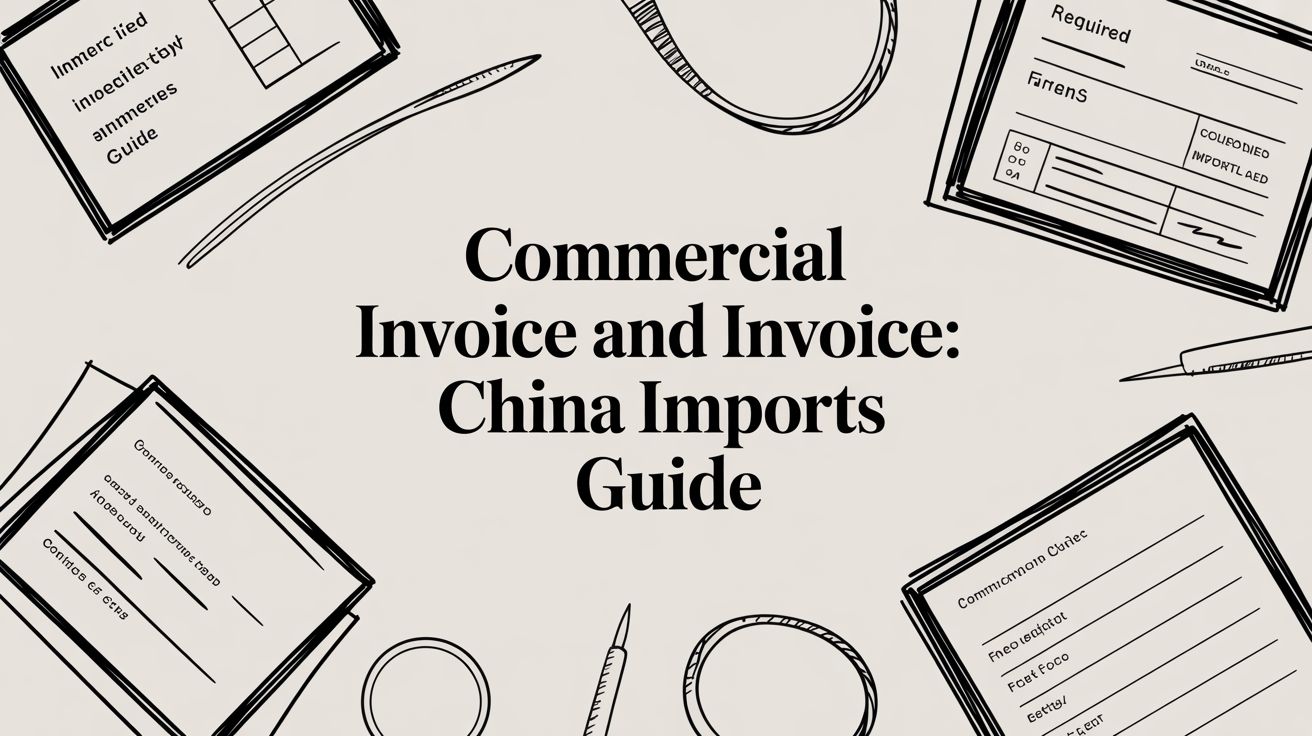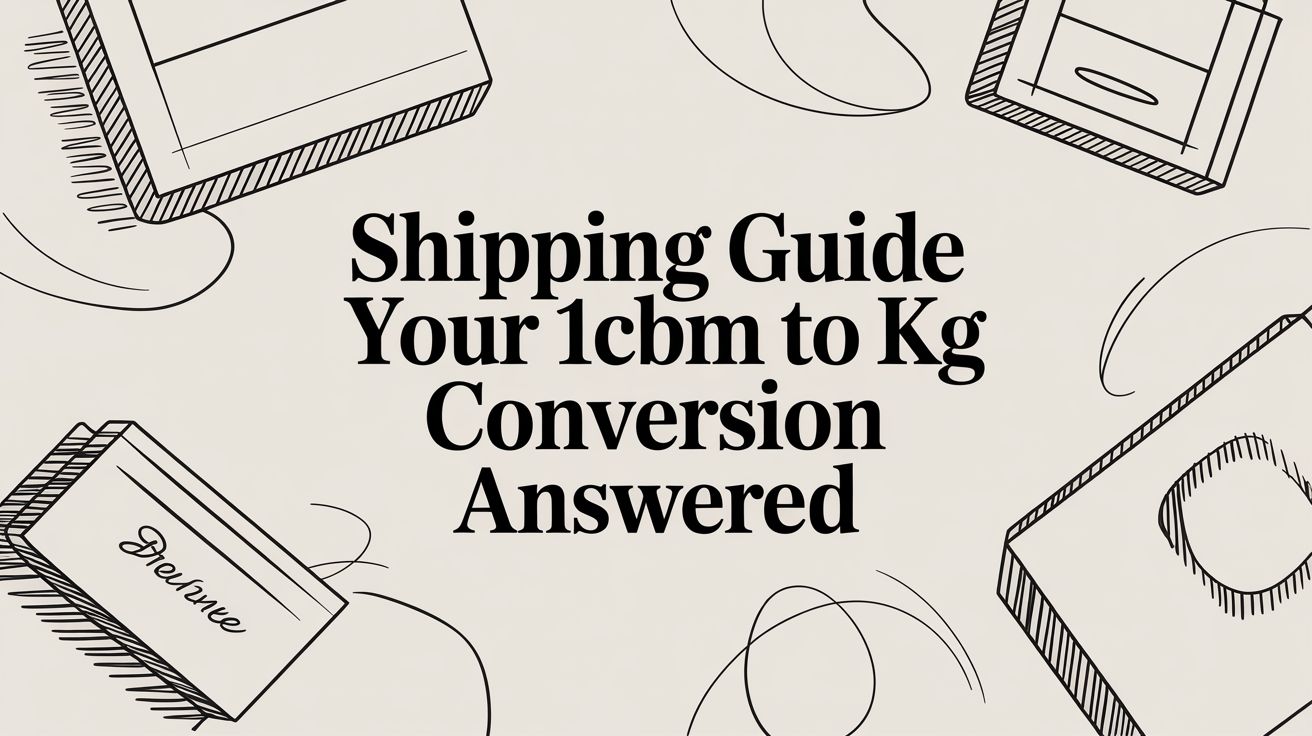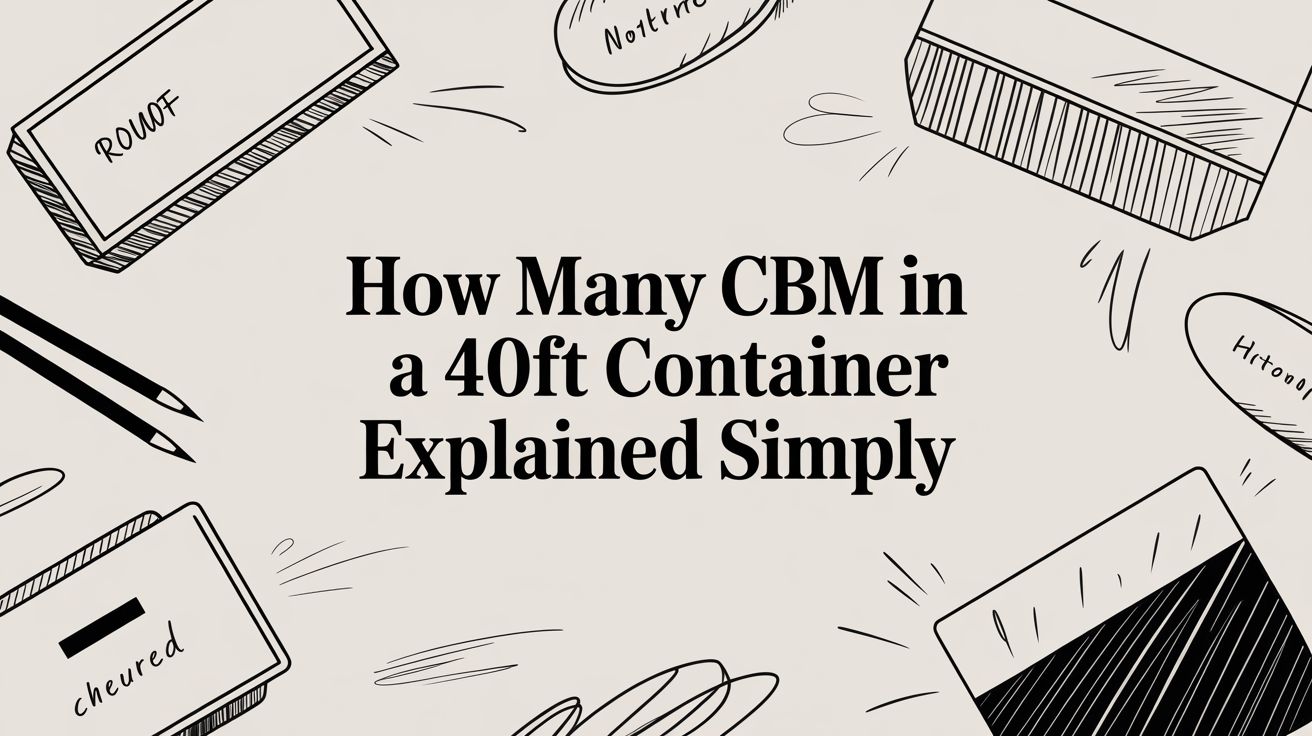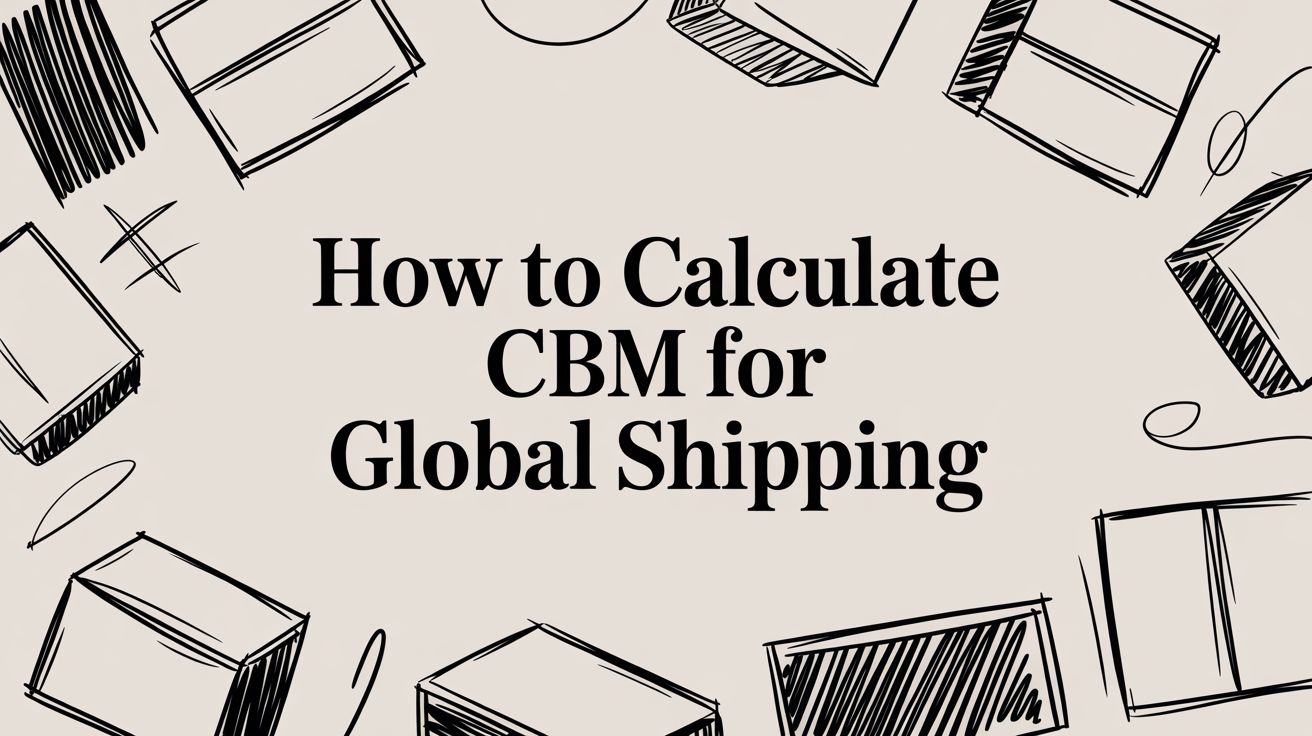If you've ever dealt with shipping, you've seen an invoice. But when you start importing from places like China, you’ll hear the term “commercial invoice,” and it's a completely different beast. Getting them mixed up is a rookie mistake that can cost you dearly.
The easiest way to think about it is this: a standard invoice is just a bill for a transaction inside your own country. A commercial invoice, however, is your shipment's passport. It’s a legal document required to get your goods across international borders and through customs.
Unpacking the Roles of Commercial and Standard Invoices
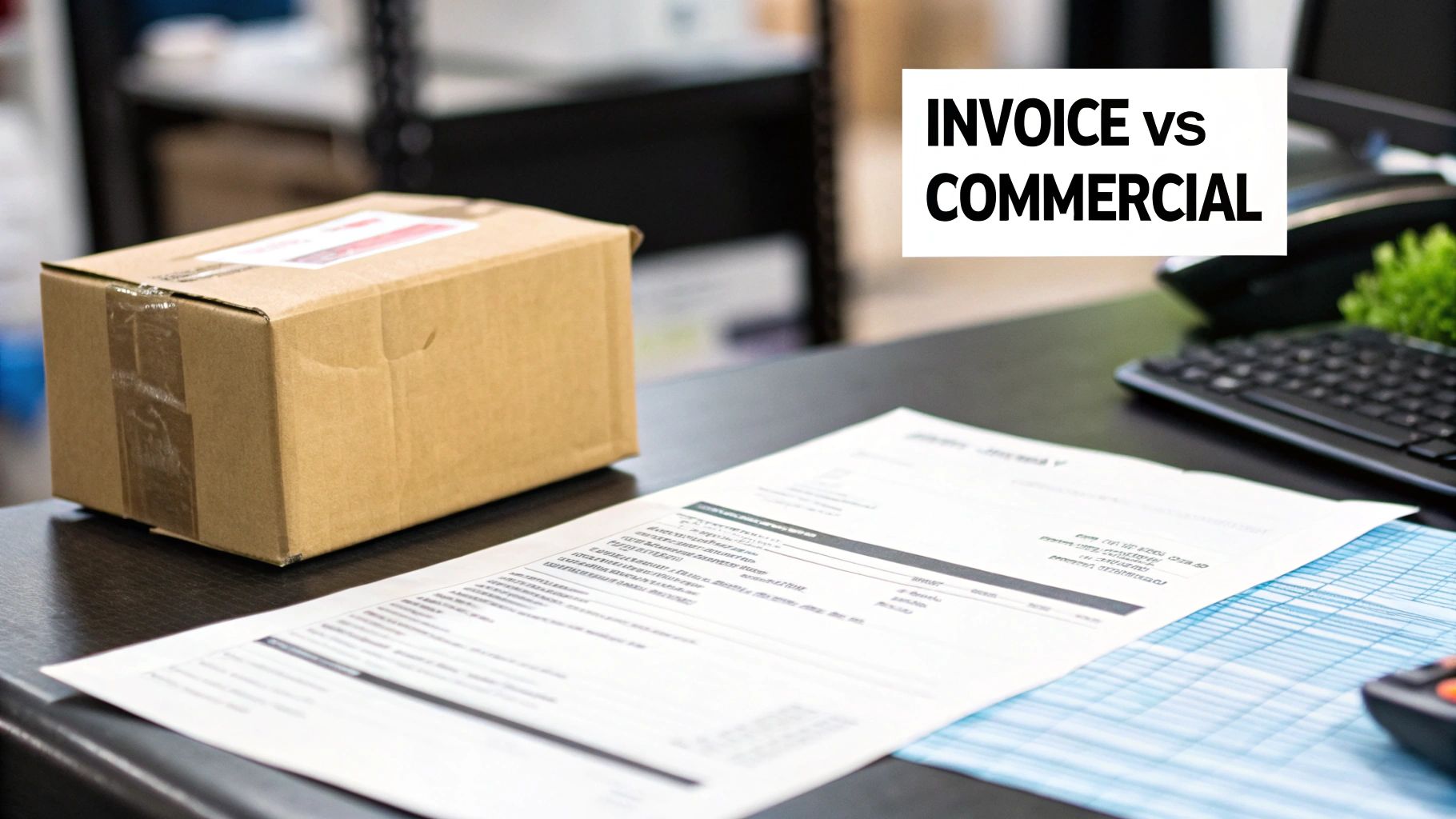
On the surface, both documents look similar. They'll both have the buyer's and seller's names, list the products, and state the prices. But that's where the similarities end. Their purpose and the audience they're written for are worlds apart.
A standard invoice is all about accounting. It’s a straightforward request for payment between two parties in the same country. A commercial invoice, on the other hand, is a critical declaration for government officials—the customs authorities who decide if your shipment can enter the country.
The Standard Invoice: A Domestic Focus
The job of a standard invoice is simple and stays within the company's and customer's view. Its main goals are pretty clear-cut:
- Getting Paid: It clearly tells the customer what they owe and when it's due.
- Bookkeeping: It’s a key document for both the buyer and seller to track sales, manage inventory, and keep their financial records straight.
- Proof of Sale: It acts as a receipt, which is essential for things like returns or warranty claims.
Since it’s only meant for the buyer and seller, it doesn’t need a lot of detail. You won't see things like country of origin, freight terms, or HS codes on a domestic invoice. Why? Because for a local sale, nobody needs that information.
Key Takeaway: If your business only operates within your country's borders, the standard invoice is all you'll ever need. The game changes the second your goods cross an international line.
The Commercial Invoice: An International Necessity
When you’re importing goods, especially from a massive manufacturing hub like China, the commercial invoice is the absolute cornerstone of your shipment. It’s much more than a request for payment; it’s a legal declaration.
Customs officers in your country depend entirely on this document to do their job. They use it to classify your products, figure out the correct import duties and taxes, and check for any prohibited or restricted items. This is why every single detail on the commercial invoice is scrutinised.
A small error—a slightly vague product description, the wrong value, or a missing detail—can bring your entire supply chain to a screeching halt. Your goods could be held up at the port for weeks, flagged for a manual (and expensive) inspection, or even land you with hefty fines.
For a smooth customs process, your commercial invoice must be flawless and perfectly match your packing list and bill of lading. Getting this right is the first—and most important—step for any successful importer.
To make it even clearer, let's break down the core differences in a simple table.
Invoice vs Commercial Invoice at a Glance
This table provides a quick side-by-side look at what sets these two critical documents apart.
| Feature | Standard Invoice | Commercial Invoice |
|---|---|---|
| Primary Purpose | To request payment for goods or services sold. | To declare shipment details for customs clearance. |
| Audience | Buyer and Seller (for accounting). | Customs authorities, brokers, freight forwarders, and financial institutions. |
| Geographic Scope | Domestic transactions (within the same country). | International transactions (between different countries). |
| Required Information | Basic details: products, quantities, prices, taxes. | Extensive details: HS codes, country of origin, Incoterms, reason for export, and more. |
| Legal Status | A financial document for billing and record-keeping. | A legally binding declaration used by government agencies to assess duties and ensure compliance. |
As you can see, while both are "invoices," their roles in the world of commerce couldn't be more different. One manages the money between two parties, while the other navigates the complex legal landscape of global trade.
Anatomy of a Perfect Commercial Invoice
Think of your commercial invoice as a passport for your goods. It’s not just a bill; it's a detailed story that tells customs officials everything they need to know about your shipment. Every field is a chapter in that story, explaining your product's journey from a factory in China to your doorstep. If you get the story right—no missing pages, no confusing details—your shipment sails through customs.
A solid commercial invoice needs to cover several key pieces of information. While your standard invoice is mostly about what was sold and for how much, the commercial invoice for international shipping has to answer the who, where, why, and how as well. Each detail is there for a reason, helping with customs valuation, security checks, and calculating duties.
The Who, What, and Where: Core Details
First things first, you need to introduce the main characters and the product itself. This information has to be perfectly consistent across all your other shipping documents, like the Bill of Lading and Packing List. No discrepancies allowed.
- Exporter/Shipper Details: This is the full legal name and address of your supplier or manufacturer in China. It clearly states who is sending the goods.
- Consignee/Importer Details: This is you. Your company’s full legal name, address, and tax ID number are required here, identifying who is officially receiving the shipment.
- Precise Goods Description: This is no place for vagueness. "Electronics" or "machine parts" won't cut it and will raise immediate red flags. You need to be specific, like: "5,000 units of Model T-800 wireless Bluetooth earbuds, black." The more detail, the less room there is for customs to misinterpret anything.
The Language of Trade: Valuation and Classification
With the basics covered, the invoice gets into the nitty-gritty details that customs officials use to classify your goods and figure out how much they're worth. This is where accuracy is absolutely critical because these fields directly determine how much tax and duty you’ll end up paying.
Harmonized System (HS) Codes: This is probably the single most important field on the entire document. The HS code is a universal numeric code that classifies every product imaginable. For instance, a wireless earbud might fall under HS code 8518.30. Customs uses this code to look up the exact tariff rate for your product. Getting it wrong can lead to nasty fines and hold-ups.
Country of Origin: This simply states where the goods were made—in this case, China. This detail is crucial for determining which trade agreements, tariffs, or import restrictions apply. If you want to get a better handle on this, you can learn more about the role of a Certificate of Origin in our guide at https://upfreights.com/blog/letter-of-origin.
Incoterms: These are standardized trade terms that spell out who is responsible for what during the shipping process—the buyer or the seller. You’ll see terms like FOB (Free On Board) or EXW (Ex Works). The Incoterm you agree on with your supplier dictates who pays for shipping, insurance, and other costs, so it must be clearly stated.
A classic mistake we see all the time is a mismatch between the value declared on the commercial invoice and the actual amount paid to the supplier. Customs agencies have smart systems to detect undervaluation, and it's treated as a serious offence.
Finally, the invoice needs a clear and simple financial summary.
- Unit Price and Total Value: Show the price for a single item and then the total value for each line item.
- Currency: Don't forget to state the currency, whether it's USD, EUR, or something else.
- Reason for Export: Briefly explain the purpose, like "Commercial Sale," "Sample for evaluation," or "Return for Repair."
To make sure you're getting everything right, using well-structured invoice templates can be a huge help. Taking the time to fill out every field completely and accurately is your best insurance policy against customs headaches. It can mean the difference between a smooth, on-time delivery and a shipment stuck in limbo for weeks.
Why Accurate Invoicing Is Your Key to Chinese Customs
When you're importing from China, think of your commercial invoice as more than just a bill. It's a sworn legal statement you're making to customs officials, and it forms the very bedrock of your entire customs declaration. Getting it wrong isn't just a minor paperwork hiccup; it's a serious compliance issue that can hit your wallet hard.
Any discrepancy, even a tiny one, can set off a chain reaction of problems. If the value on your commercial invoice doesn't line up perfectly with what's on your packing list or the official customs declaration, it immediately raises a red flag. This can lead to your shipment being pulled aside for a full-blown inspection, hefty fines, or, in the worst-case scenario, your goods being seized.
Don't think a small mistake will slip through. The General Administration of Customs of China (GACC) uses sophisticated data-matching systems that cross-reference every document you submit, hunting for the slightest inconsistency. Being meticulous isn't just good business—it's your best defence against delays that can bring your entire supply chain to a standstill.
The Regulatory Landscape and Stricter Enforcement
China's export regulations are always being refined, and the push is consistently towards greater precision from shippers. A significant overhaul in 2025 tightened the rules around export compliance considerably. Specifically, Announcement No. 8 (2025), which took effect on October 1, 2025, brought in stricter requirements for how Value-Added Tax (VAT) is managed on exports.
In practical terms, this means Chinese customs and tax authorities now have systems that automatically cross-check invoice data against customs declarations and payment records. They can spot inconsistencies faster and more efficiently than ever.
This shift points to a more aggressive enforcement strategy, with clear penalties for anyone who submits inaccurate or late paperwork. For importers, this really drives home the need to partner with suppliers who know these rules inside and out. It's a critical piece of your risk management strategy. Given that Hong Kong as a gateway to China for trading is a common route, understanding these regulations is absolutely essential for a smooth journey.
This infographic breaks down the essential components of a flawless commercial invoice into three key areas: People, Product, and Journey.

This visual guide helps reinforce that every single detail—from who is shipping the goods to where they are going—is interconnected and vital for compliance.
Protecting Your Shipment from Customs Delays
At the end of the day, the accuracy of your commercial invoice is what stands between your shipment and a smooth, hassle-free clearance. An error-free document signals to customs officials that you're a compliant, trustworthy importer, which significantly lowers the odds of your cargo being flagged for a manual inspection.
Key Insight: A perfect commercial invoice is your first line of defence. It minimises risk, ensures predictability in your supply chain, and protects your bottom line from unexpected customs penalties.
Making sure every detail is spot-on before your goods leave China is non-negotiable. This proactive step doesn't just save you from surprise costs; it also helps build a solid reputation with customs authorities, paving the way for easier clearances on future shipments. Nailing your documentation is a crucial part of a successful https://upfreights.com/customs-clearance process.
Avoiding Common Commercial Invoice Mistakes
I’ve seen it happen more times than I can count: even veteran importers get tripped up by simple mistakes on a commercial invoice. These slip-ups, which often start with a supplier's oversight, can spiral into serious, expensive headaches at the border. The best way to keep your shipments moving smoothly is to know what these common pitfalls are and how to sidestep them.
You have to remember, what looks like a tiny error to you can look like an attempt to dodge duties to a customs officer. That’s why you need to treat every single field on the commercial invoice as a critical piece of data that has to be 100% accurate.
Vague or Inaccurate Product Descriptions
This is probably the biggest and most damaging mistake I see. A supplier will just write "auto parts" or "electronics" on the invoice, which tells customs absolutely nothing. Descriptions that vague are giant red flags.
- Wrong Way: "10 boxes of machine parts." This is useless. It gives no information for classification or valuation.
- Right Way: "10 boxes containing 500 units each (5,000 units total) of Model X automotive fuel injectors, Part No. 45-2B."
See the difference? That level of detail gives customs everything they need to identify the product, confirm its value, and assign the right HS Code. Without it, you’re practically inviting them to pull your shipment aside for a manual inspection, which can easily add weeks to your timeline.
Incorrect HS Codes and Mismatched Values
Using the wrong Harmonized System (HS) code is another classic blunder with big financial implications. Get the code wrong, and you could end up overpaying—or worse, underpaying—your duties. If customs finds you've underpaid because of a bad code, you're on the hook for the difference, plus some hefty fines.
On top of that, the values you declare on the commercial invoice have to match exactly across all your other documents, like the packing list and the bill of lading.
Crucial Reminder: One of the quickest ways to get your shipment held is a valuation dispute. If the price you’ve declared looks too good to be true for the type and quantity of goods, customs will almost certainly flag it. They'll demand proof of payment to make sure the transaction was legitimate.
This is where mismatched financial records can really sink you. Any inconsistency looks like you're trying to get out of paying the correct taxes. It’s vital to understand the full picture of import costs; our guide on VAT when importing from China is a great place to get a handle on these financial responsibilities.
Missing or Incomplete Information
Leaving fields blank on a commercial invoice is a complete non-starter. Every single box, from the consignee’s tax ID to the Incoterms, is there for a reason and is required by law.
Some of the most commonly forgotten details include:
- Country of Origin: Absolutely essential for figuring out tariffs and if any trade agreements apply.
- Incoterms: These terms define who is responsible for what, which directly impacts how customs calculates the value of your goods.
- Currency: Forgetting to specify the currency (USD, EUR, etc.) just creates confusion and delays.
To help you get ahead of these issues, we've put together a quick table outlining the most frequent errors we see and what can happen if they aren't fixed.
Common Invoice Errors and Their Consequences
| Common Error | Potential Consequence | How to Fix It |
|---|---|---|
| Generic Descriptions (e.g., "Gifts") | Delayed clearance, manual inspections, potential re-classification by customs. | Provide highly specific details: model numbers, materials, intended use, and part numbers. |
| Incorrect HS Code | Over or underpayment of duties, fines, seizure of goods, future shipment scrutiny. | Use an online HS code lookup tool or consult a customs broker. Double-check with your supplier. |
| Value Mismatch | Customs hold for valuation review, requests for proof of payment, penalties for undervaluation. | Ensure the invoice value matches the packing list, bill of lading, and your actual payment records. |
| Missing Incoterms | Confusion over liability, incorrect duty/tax calculation, delivery disputes. | Clearly state the agreed-upon Incoterm (e.g., FOB Shanghai, CIF Los Angeles) on the invoice. |
| No Country of Origin | Inability to claim preferential tariff rates, potential rejection at the border. | Always list the country where the goods were manufactured, not just shipped from. |
The key takeaway is to be proactive. By carefully reviewing every invoice from your supplier before the goods are shipped, you can catch these problems early. A simple checklist based on these common mistakes can be an incredibly effective tool for protecting your supply chain from delays you can’t afford.
Embracing Digital Documentation in Your Import Process
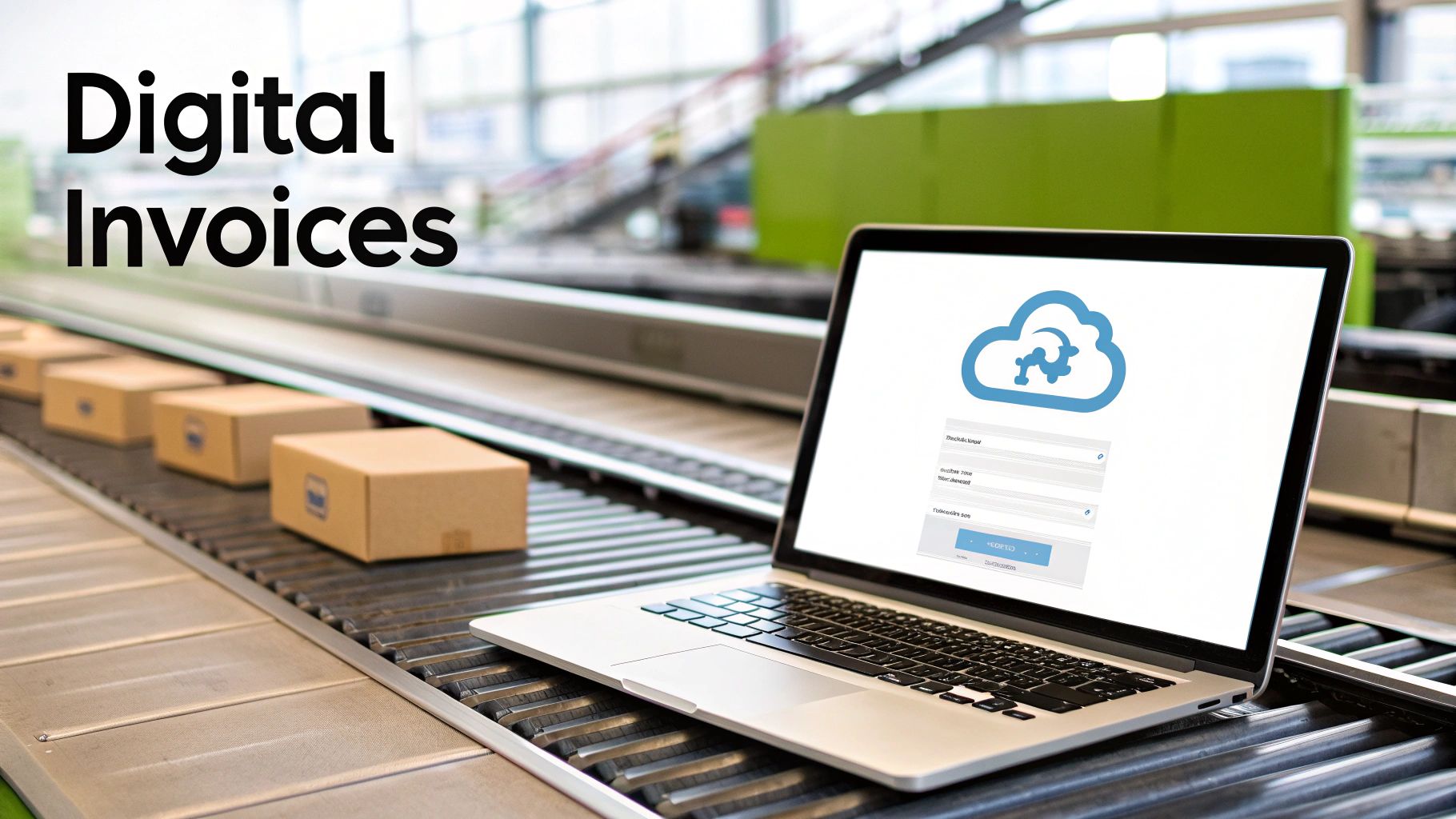
The days of shuffling paper, chasing email attachments, and wrestling with manual data entry are numbered. If you're importing goods, especially from a powerhouse like China, the future is undeniably digital. This isn't just about saving a few trees; it's a fundamental shift in how we manage critical documents like the commercial invoice and invoice. Making the switch is no longer a "nice-to-have"—it's a strategic move essential for staying competitive.
For importers, this means graduating from scanned PDFs and endless email threads to truly integrated digital platforms. Imagine a world where your commercial invoice is a live document, instantly accessible and verifiable by your supplier in China, your freight forwarder, and your customs broker. This creates a single, undisputed source of truth, slashing the manual errors that are notorious for causing expensive, frustrating delays at the border.
This digital wave is reshaping global trade, and nowhere is that more obvious than in China. The country's explosive growth in cross-border e-commerce is a perfect case study.
The Rise of Digital Trade in China
Think about the sheer volume of goods moving out of China daily. The country's booming e-commerce market depends entirely on hyper-efficient digital systems to process millions of transactions. In just the first half of 2025, this trade hit a staggering RMB 1.32 trillion (US$182 billion), with imports alone jumping by 9.3 percent. That kind of volume is simply impossible to manage with paper. It underscores why having a slick, digital commercial invoice process is so critical for compliance and speed. You can dive deeper into the latest Chinese import trends and their implications to see where the market is heading.
This push isn't just happening in e-commerce, either. As of October 1, 2025, the Chinese government fully digitised all invoicing for railway and air travel. It's a clear signal of a broader, top-down initiative to move away from paper. For importers, the message is clear: adapt now or get left behind.
Benefits of a Digital-First Approach
Adopting digital documentation isn’t just about modernising; it delivers real, tangible benefits that directly impact your bottom line and make your supply chain far more robust.
Here’s what you stand to gain:
- Fewer Manual Errors: Automating data entry all but eliminates the typos and small inconsistencies that so often lead to customs holds and inspections.
- Faster Information Sharing: Data flows instantly between everyone involved. This dramatically speeds up customs clearance, logistics planning, and final delivery.
- Greater Transparency: When everyone is working from the same live document, there's nowhere to hide. This boosts accountability and gives you a clear view of your shipment's journey.
By adopting digital invoicing, you're not just going paperless. You are building a more efficient, transparent, and resilient supply chain prepared for the future of global trade.
Ultimately, integrating these digital processes helps you stay ahead of the curve. It positions your business to thrive in the incredibly fast-paced and demanding world of international importing.
Your China Import Invoice Questions Answered
We get a lot of questions about the tricky, real-world situations that pop up when dealing with commercial invoices. The standard guides don't always cover the "what if" scenarios, so let's tackle a few of the most common ones you'll likely face when importing from China.
How Do I Handle Shipments with No Commercial Value?
This is a classic. You've got free samples coming, or maybe a replacement part under warranty. You didn't pay for it, so what do you put on the invoice?
Every single shipment, paid for or not, needs a commercial invoice. Customs simply won't process it otherwise. You can't just put zero on the form. The key is to declare a realistic, fair market value for the items, even if it's a nominal amount like $1.00 USD per unit.
Make sure the invoice clearly states: "Value for customs purposes only. No commercial value." This little sentence tells customs officials exactly what they're looking at and shows you're not trying to dodge duties by undervaluing your goods.
Who Is Legally Responsible for Invoice Accuracy?
This is a point of confusion that can get importers into serious trouble. Your supplier in China prepares the commercial invoice, but when it comes to the crunch, the legal responsibility for its accuracy lands squarely on you, the importer.
Think of it this way: you're the one making a legal declaration to your country's customs agency. If the information is wrong, you're the one facing the fines, delays, and potential legal headaches. That’s why you have to double-check every single document your supplier sends before your shipment even thinks about leaving the port. Never just assume it's right—always verify.
What If an Invoice Needs to Be Corrected After Shipping?
It happens. An error is spotted on the commercial invoice, but the goods are already on the water. The absolute worst thing you can do is wait for customs to find the mistake.
You need to be proactive, and fast. Here’s what to do:
- Get in touch with your supplier immediately and have them issue a corrected invoice. It must be clearly marked as "Amended" or "Corrected."
- Alert your freight forwarder or customs broker right away. Send them both the original, incorrect invoice and the new, corrected one.
- File a formal correction with customs. Your broker is your best friend here; they can guide you through the specific process, which might be a post-entry amendment.
Taking these steps shows customs you're acting in good faith. It proves you're committed to compliance and can save you from much bigger penalties and problems down the line.
